Assessment of Regional Climate Effects of Urbanization around Subtropical City Wuhan in Summer Using Numerical Modeling
Abstract
:1. Introduction
2. Materials and Methods
2.1. WRF-SLUCM Modelling System and Configurations
2.2. Urban Impervious Area Dataset
2.3. Model Evaluation Data
2.4. Design of Experiments
3. Results
3.1. Evaluation of Model Performance with Gridded Observations
3.2. Impacts on Surface Air Temperature and Surface Skin Temperature
3.3. Impacts on Surface Energy Budget
3.4. Impacts on Planetary Boundary Layer Height and 2 m Water Vapor Content
3.5. Vertical Distribution of Air Temprature and Water Vapor Mixing Ratio
4. Discussion
5. Conclusions
- (1)
- Urban expansion leads to increases of 0.63 °C and 0.83 °C for an average 2 m air temperature and surface skin temperature over urban areas. Both T2m and Tskin present more pronounced warming in nighttime (with average magnitudes of 0.88 °C and 1.09 °C) than in daytime (with average magnitudes of 0.42 °C and 0.62 °C).
- (2)
- Urbanization leads to surface sensible heat flux increases of 24.7 ± 20.0 W/m2 and latent heat flux decreases of −36.5 ± 34.5 W/m2. These effects are much greater in daytime than in nighttime. Ground heat flux changes with a magnitude of 1.4 ± 2.5 W/m2. It decreases during the daytime but rises during the nighttime.
- (3)
- The PBLH increases over urbanized areas with its maximum value over 100 m. The 2 m water vapor mixing ratio decreases over most urbanized areas, which can reach −2 g/kg.
- (4)
- The urbanization effect can penetrate the overlying atmosphere. The cross-section around Wuhan city (along 114.22°E from 30.40 to 30.70°N) shows that urbanization increases air temperature and that the heating effect of urbanization may extend to approximately 0.3 km above ground level with a maximum of 0.65 °C near the ground. The decline of the water vapor mixing ratio also occurs below 0.3 km with its peak value beyond −0.44 g/kg near the ground.
Funding
Institutional Review Board Statement
Informed Consent Statement
Data Availability Statement
Acknowledgments
Conflicts of Interest
References
- Oke, T.R. The energetic basis of the urban heat island. Q. J. R. Meteorol. Soc. 1982, 108, 1–24. [Google Scholar] [CrossRef]
- de Foy, B.; Molina, L.T.; Molina, M.J. Satellite-derived land surface parameters for mesoscale modelling of the Mexico City basin. Atmos. Chem. Phys. 2006, 6, 1315–1330. [Google Scholar] [CrossRef]
- Li, M.M.; Song, Y.; Huang, X.; Li, J.F.; Mao, Y.; Zhu, T.; Cai, X.H.; Liu, B. Improving mesoscale modeling using satellite-derived land surface parameters in the Pearl River Delta region, China. J. Geophys. Res. Atmos. 2014, 119, 6325–6346. [Google Scholar] [CrossRef]
- Ludwig, F.L.; Dabberdt, W.F. Effects of urbanization on turbulent diffusion and mixing depth. Int. J. Biometeorol. 1973, 17, 1–11. [Google Scholar] [CrossRef]
- Yang, L.; Smith, J.A.; Baeck, M.L.; Bou-Zeid, E.; Jessup, S.M.; Tian, F.Q.; Hu, H.P. Impact of Urbanization on Heavy Convective Precipitation under Strong Large-Scale Forcing: A Case Study over the Milwaukee-Lake Michigan Region. J. Hydrometeorol. 2014, 15, 261–278. [Google Scholar] [CrossRef]
- Jones, P.D.; Lister, D.H.; Li, Q. Urbanization effects in large-scale temperature records, with an emphasis on China. J. Geophys. Res. Atmos. 2008, 113, 9916. [Google Scholar] [CrossRef]
- Ren, G.Y.; Zhou, Y.Q.; Chu, Z.Y.; Zhou, J.X.; Zhang, A.Y.; Guo, J.; Liu, X.F. Urbanization effects on observed surface air temperature trends in north China. J. Clim. 2008, 21, 1333–1348. [Google Scholar] [CrossRef]
- Kalnay, E.; Cai, M. Impact of urbanization and land-use change on climate. Nature 2003, 423, 528–531. [Google Scholar] [CrossRef]
- Zhou, L.; Dickinson, R.E.; Tian, Y.; Fang, J.; Li, Q.; Kaufmann, R.K.; Tucker, C.J.; Myneni, R.B. Evidence for a significant urbanization effect on climate in China. Proc. Natl. Acad. Sci. 2004, 101, 9540–9544. [Google Scholar] [CrossRef]
- Miao, S.; Chen, F.; Lemone, M.A.; Tewari, M.; Li, Q.; Wang, Y. An Observational and Modeling Study of Characteristics of Urban Heat Island and Boundary Layer Structures in Beijing. J. Appl. Meteorol. Climatol. 2009, 48, 484–501. [Google Scholar] [CrossRef]
- Chen, F.; Yang, X.; Zhu, W. WRF simulations of urban heat island under hot-weather synoptic conditions: The case study of Hangzhou City, China. Atmos. Res. 2014, 138, 364–377. [Google Scholar] [CrossRef]
- Yang, B.; Zhang, Y.C.; Qian, Y. Simulation of urban climate with high-resolution WRF model: A case study in Nanjing, China. Asia-Pac. J. Atmos. Sci. 2012, 48, 227–241. [Google Scholar] [CrossRef]
- Georgescu, M.; Moustaoui, M.; Mahalov, A.; Dudhia, J. Summer-time climate impacts of projected megapolitan expansion in Arizona. Nat. Clim. Change 2013, 3, 37–41. [Google Scholar] [CrossRef]
- Vahmani, P.; Ban-Weiss, G.A. Impact of remotely sensed albedo and vegetation fraction on simulation of urban climate in WRF-urban canopy model: A case study of the urban heat island in Los Angeles. J. Geophys. Res. Atmos. 2016, 121, 1511–1531. [Google Scholar] [CrossRef]
- Wang, J.; Feng, J.M.; Yan, Z.W.; Hu, Y.H.; Jia, G.S. Nested high-resolution modeling of the impact of urbanization on regional climate in three vast urban agglomerations in China. J. Geophys. Res. Atmos. 2012, 117. [Google Scholar] [CrossRef]
- Feng, J.M.; Wang, Y.L.; Ma, Z.G.; Liu, Y.H. Simulating the Regional Impacts of Urbanization and Anthropogenic Heat Release on Climate across China. J. Clim. 2012, 25, 7187–7203. [Google Scholar] [CrossRef]
- Lin, S.; Feng, J.; Wang, J.; Hu, Y. Modeling the contribution of long-term urbanization to temperature increase in three extensive urban agglomerations in China. J. Geophys. Res. Atmos. 2016, 121, 1683–1697. [Google Scholar] [CrossRef]
- Cao, Q.; Yu, D.Y.; Georgescu, M.; Wu, J.G. Impacts of urbanization on summer climate in China: An assessment with coupled land-atmospheric modeling. J. Geophys. Res. Atmos. 2016, 121, 10505–10521. [Google Scholar] [CrossRef]
- Bounoua, L.; Zhang, P.; Mostovoy, G.; Thome, K.; Masek, J.; Imhoff, M.; Shepherd, M.; Quattrochi, D.; Santanello, J.; Silva, J.; et al. Impact of urbanization on US surface climate. Environ. Res. Lett. 2015, 10, 84010. [Google Scholar] [CrossRef]
- Chen, L.; Frauenfeld, O.W. Impacts of urbanization on future climate in China. Clim. Dyn. 2016, 47, 345–357. [Google Scholar] [CrossRef]
- Argüeso, D.; Evans, J.P.; Fita, L.; Bormann, K.J. Temperature response to future urbanization and climate change. Clim. Dyn. 2014, 42, 2183–2199. [Google Scholar] [CrossRef]
- Wang, M.; Zhang, X.; Yan, X. Modeling the climatic effects of urbanization in the Beijing–Tianjin–Hebei metropolitan area. Theor. Appl. Climatol. 2013, 113, 377–385. [Google Scholar] [CrossRef]
- Goswami, P.; Shivappa, H.; Goud, B.S. Impact of urbanization on tropical mesoscale events: Investigation of three heavy rainfall events. Meteorol. Z. 2010, 19, 385–397. [Google Scholar] [CrossRef]
- Wang, X.M.; Liao, J.B.; Zhang, J.; Shen, C.; Chen, W.H.; Xia, B.C.; Wang, T.J. A Numeric Study of Regional Climate Change Induced by Urban Expansion in the Pearl River Delta, China. J. Appl. Meteorol. Climatol. 2014, 53, 346–362. [Google Scholar] [CrossRef]
- Feng, J.M.; Wang, Y.L.; Ma, Z.G. Long-term simulation of large-scale urbanization effect on the East Asian monsoon. Clim. Change 2015, 129, 511–523. [Google Scholar] [CrossRef]
- Lo, J.C.F.; Lau, A.K.H.; Chen, F.; Fung, J.C.H.; Leung, K.K.M. Urban modification in a mesoscale model and the effects on the local circulation in the Pearl River Delta region. J. Appl. Meteorol. Climatol. 2007, 46, 457–476. [Google Scholar] [CrossRef]
- Li, M.M.; Mao, Z.C.; Song, Y.; Liu, M.X.; Huang, X. Impacts of the Decadal Urbanization on Thermally Induced Circulations in Eastern China. J. Appl. Meteorol. Climatol. 2015, 54, 259–282. [Google Scholar] [CrossRef]
- Wang, M.N.; Xiong, Z.; Yan, X.D. Modeling the climatic effects of the land use/cover change in eastern China. Phys. Chem. Earth 2015, 87–88, 97–107. [Google Scholar] [CrossRef]
- Zhang, N.; Gao, Z.; Wang, X.; Chen, Y. Modeling the impact of urbanization on the local and regional climate in Yangtze River Delta, China. Theor. Appl. Climatol. 2010, 102, 331–342. [Google Scholar] [CrossRef]
- Zhao, G.; Dong, J.; Cui, Y.; Liu, J.; Zhai, J.; He, T.; Zhou, Y.; Xiao, X. Evapotranspiration-dominated biogeophysical warming effect of urbanization in the Beijing-Tianjin-Hebei region, China. Clim. Dyn. 2019, 52, 1231–1245. [Google Scholar] [CrossRef]
- Ke, X.L.; Wu, F.; Ma, C.X. Scenario Analysis on Climate Change Impacts of Urban Land Expansion under Different Urbanization Patterns: A Case Study of Wuhan Metropolitan. Adv. Meteorol. 2013, 2013, 293636. [Google Scholar] [CrossRef]
- Skamarock, W.C.; Klemp, J.B. A time-split nonhydrostatic atmospheric model for weather research and forecasting applications. J. Comput. Phys. 2008, 227, 3465–3485. [Google Scholar] [CrossRef]
- Dee, D.P.; Uppala, S.M.; Simmons, A.J.; Berrisford, P.; Poli, P.; Kobayashi, S.; Andrae, U.; Balmaseda, M.A.; Balsamo, G.; Bauer, P.; et al. The ERA-Interim reanalysis: Configuration and performance of the data assimilation system. Q. J. R. Meteorol. Soc. 2011, 137, 553–597. [Google Scholar] [CrossRef]
- Kusaka, H.; Kimura, F. Coupling a single-layer urban canopy model with a simple atmospheric model: Impact on urban heat island simulation for an idealized case. J. Meteorol. Soc. Jpn. 2004, 82, 67–80. [Google Scholar] [CrossRef]
- Kusaka, H.; Kondo, H.; Kikegawa, Y.; Kimura, F. A simple single-layer urban canopy model for atmospheric models: Comparison with multi-layer and slab models. Bound.-Layer Meteorol. 2001, 101, 329–358. [Google Scholar] [CrossRef]
- Gong, P.; Xuecao, L.; Wang, J.; Bai, Y.; Chen, B.; Ty, H.; Liu, X.; Xu, B.; Yang, J.; Zhang, W.; et al. Annual maps of global artificial impervious area (GAIA) between 1985 and 2018. Remote Sens. Environ. 2019, 236, 111510. [Google Scholar] [CrossRef]
- He, J.; Yang, K.; Tang, W.; Lu, H.; Qin, J.; Chen, Y.; Li, X. The first high-resolution meteorological forcing dataset for land process studies over China. Sci. Data 2020, 7, 25. [Google Scholar] [CrossRef]
- Ma, Q.; He, C.; Wu, J.; Liu, Z.; Zhang, Q.; Sun, Z. Quantifying spatiotemporal patterns of urban impervious surfaces in China: An improved assessment using nighttime light data. Landsc. Urban Plan. 2014, 130, 36–49. [Google Scholar] [CrossRef]
- Georgescu, M.; Miguez-Macho, G.; Steyaert, L.T.; Weaver, C.P. Climatic effects of 30 years of landscape change over the Greater Phoenix, Arizona, region: 1. Surface energy budget changes. J. Geophys. Res. Atmos. 2009, 114. [Google Scholar]
- Miao, S.; Li, Q.; Fan, S. Month-averaged impacts of urbanization on atmospheric boundary layer structure and precipitation in summer in Beijing area. Chin. J. Geophys. 2010, 53, 1580–1593. [Google Scholar]
- Stevens, B.; Ackerman, A.; Bretherton, C.; Chlond, A.; Roode, S.R.; Edwards, J.; Golaz, J.-C.; Khairoutdinov, M.; Kirkpatrick, M.; Lewellen, D.; et al. Evaluation of Large-Eddy Simulations via Observations of Nocturnal Marine Stratocumulus. Mon. Weather Rev. 2005, 133, 1443–1462. [Google Scholar] [CrossRef]
- Jung, S.-H.; Im, E.-S.; Han, S.-O. The effect of topography and sea surface temperature on heavy snowfall in the Yeongdong region: A case study with high resolution WRF simulation. Asia-Pac. J. Atmos. Sci. 2012, 48, 259–273. [Google Scholar] [CrossRef]
- Giorgi, F.; Bi, X. A study of internal variability of a regional climate model. J. Geophys. Res. Atmos. 2000, 105, 29503–29521. [Google Scholar] [CrossRef]
- Christensen, O.B.; Gaertner, M.A.; Prego, J.A.; Polcher, J. Internal variability of regional climate models. Clim. Dyn. 2001, 17, 875–887. [Google Scholar] [CrossRef]
- Separovic, L.; de Elía, R.; Laprise, R. Reproducible and Irreproducible Components in Ensemble Simulations with a Regional Climate Model. Mon. Weather Rev. 2008, 136, 4942–4961. [Google Scholar] [CrossRef]
- Bonekamp, P.N.J.; Collier, E.; Immerzeel, W.W. The Impact of Spatial Resolution, Land Use, and Spinup Time on Resolving Spatial Precipitation Patterns in the Himalayas. J. Hydrometeorol. 2018, 19, 1565–1581. [Google Scholar] [CrossRef]
- Crétat, J.; Macron, C.; Pohl, B.; Richard, Y. Quantifying internal variability in a regional climate model: A case study for Southern Africa. Clim. Dyn. 2011, 37, 1335–1356. [Google Scholar] [CrossRef]
- Fathalli, B.; Pohl, B.; Castel, T.; Safi, M.J. Errors and uncertainties in regional climate simulations of rainfall variability over Tunisia: A multi-model and multi-member approach. Clim. Dyn. 2019, 52, 335–361. [Google Scholar] [CrossRef]
- Laprise, R.; Kornic, D.; Rapaić, M.; Šeparović, L.; Leduc, M.; Nikiema, O.; Di Luca, A.; Diaconescu, E.; Alexandru, A.; Lucas-Picher, P.; et al. Considerations of Domain Size and Large-Scale Driving for Nested Regional Climate Models: Impact on Internal Variability and Ability at Developing Small-Scale Details. In Climate Change: Inferences from Paleoclimate and Regional Aspects; Springer: Vienna, Austria, 2012; pp. 181–199. [Google Scholar]
- Laux, P.; Nguyen, P.N.B.; Cullmann, J.; Van, T.P.; Kunstmann, H. How many RCM ensemble members provide confidence in the impact of land-use land cover change? Int. J. Climatol. 2017, 37, 2080–2100. [Google Scholar] [CrossRef]
- Lucas-Picher, P.; Caya, D.; Biner, S.; Laprise, R. Quantification of the Lateral Boundary Forcing of a Regional Climate Model Using an Aging Tracer. Mon. Weather Rev. 2008, 136, 4980–4996. [Google Scholar] [CrossRef]
- Sailor, D.J.; Lu, L. A top-down methodology for developing diurnal and seasonal anthropogenic heating profiles for urban areas. Atmos. Environ. 2004, 38, 2737–2748. [Google Scholar] [CrossRef]
- Sailor, D.J. A review of methods for estimating anthropogenic heat and moisture emissions in the urban environment. Int. J. Climatol. 2011, 31, 189–199. [Google Scholar] [CrossRef]
- Sailor, D.J.; Georgescu, M.; Milne, J.M.; Hart, M.A. Development of a national anthropogenic heating database with an extrapolation for international cities. Atmos. Environ. 2015, 118, 7–18. [Google Scholar] [CrossRef]
- Chen, F.; Yang, X.; Wu, J. Simulation of the urban climate in a Chinese megacity with spatially heterogeneous anthropogenic heat data. J. Geophys. Res. Atmos. 2016, 121, 5193–5212. [Google Scholar] [CrossRef]
- Rosenfeld, D. Suppression of Rain and Snow by Urban and Industrial Air Pollution. Science 2000, 287, 1793–1796. [Google Scholar] [CrossRef]
- van den Heever, S.C.; Cotton, W.R. Urban Aerosol Impacts on Downwind Convective Storms. J. Appl. Meteorol. Climatol. 2007, 46, 828–850. [Google Scholar] [CrossRef]
- Kaufmann, R.K.; Seto, K.C.; Schneider, A.; Liu, Z.; Zhou, L.; Wang, W. Climate Response to Rapid Urban Growth: Evidence of a Human-Induced Precipitation Deficit. J. Clim. 2007, 20, 2299–2306. [Google Scholar] [CrossRef]
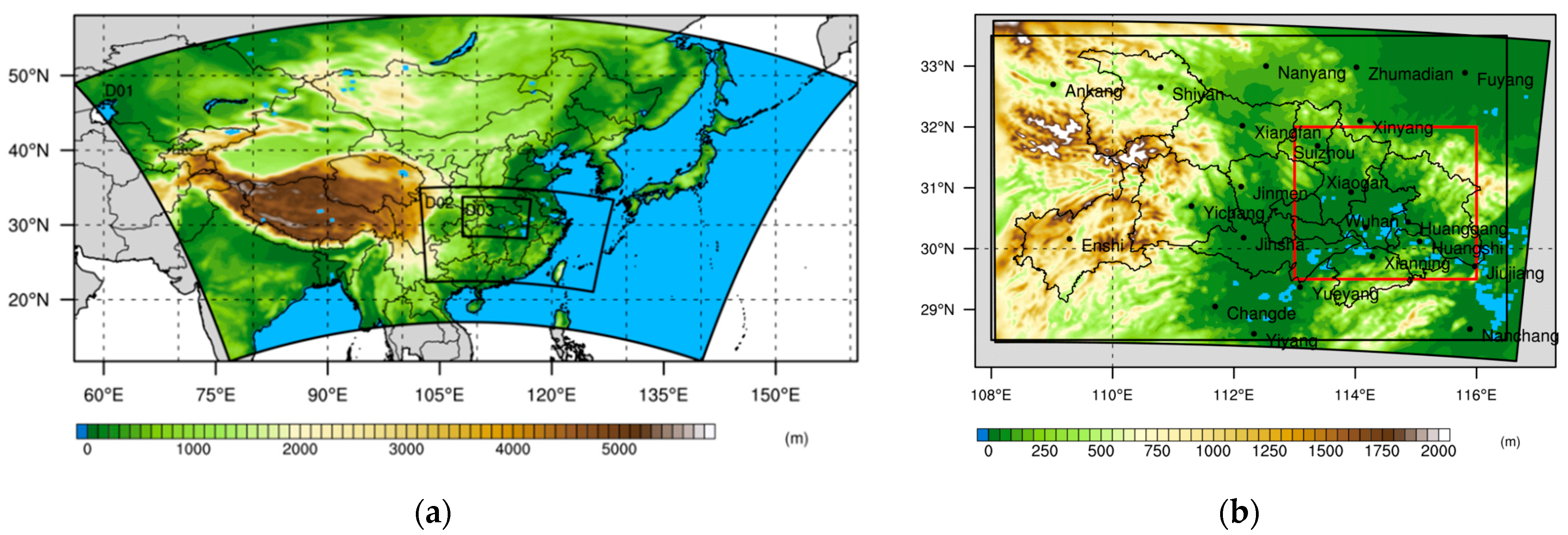
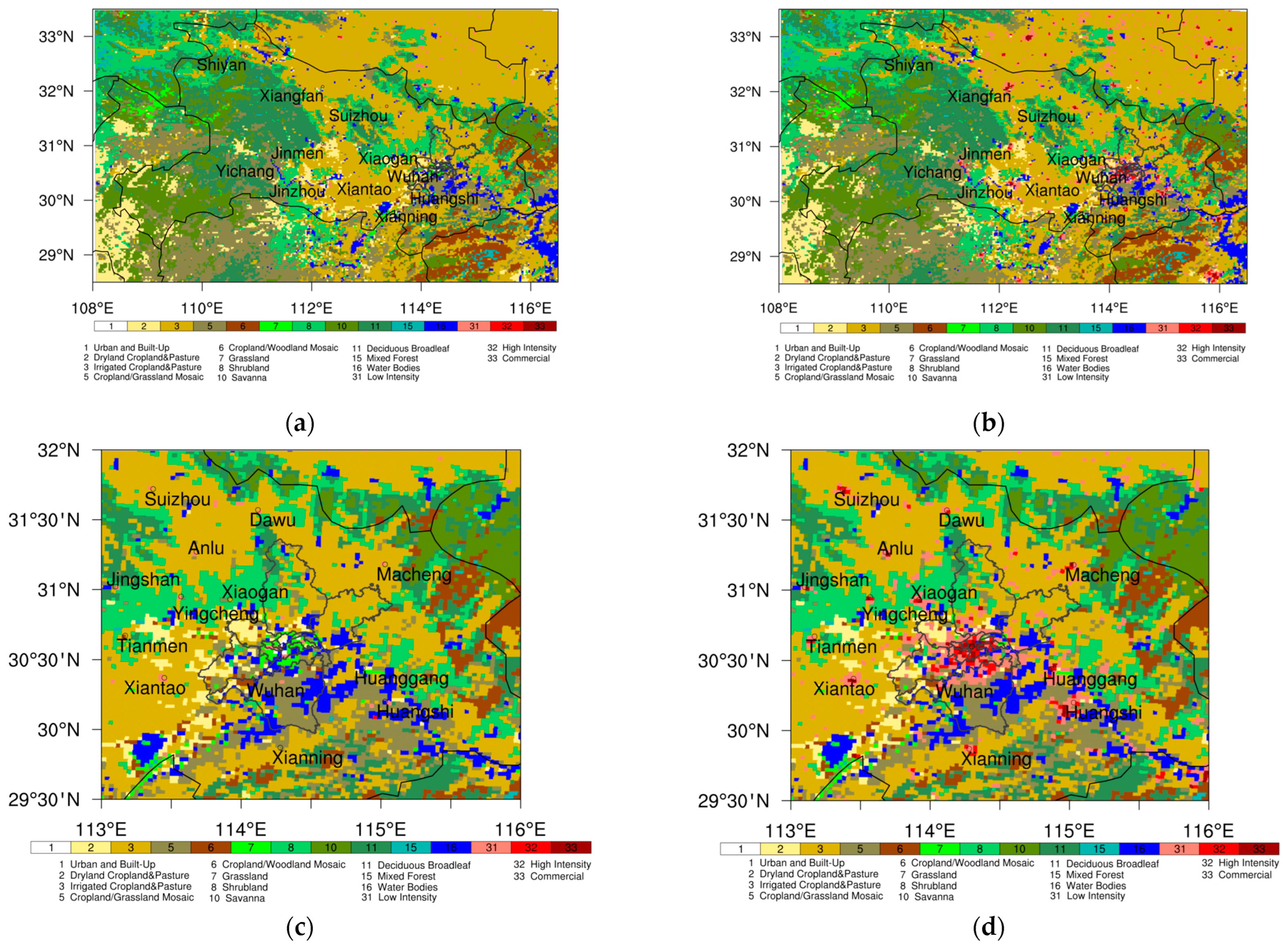

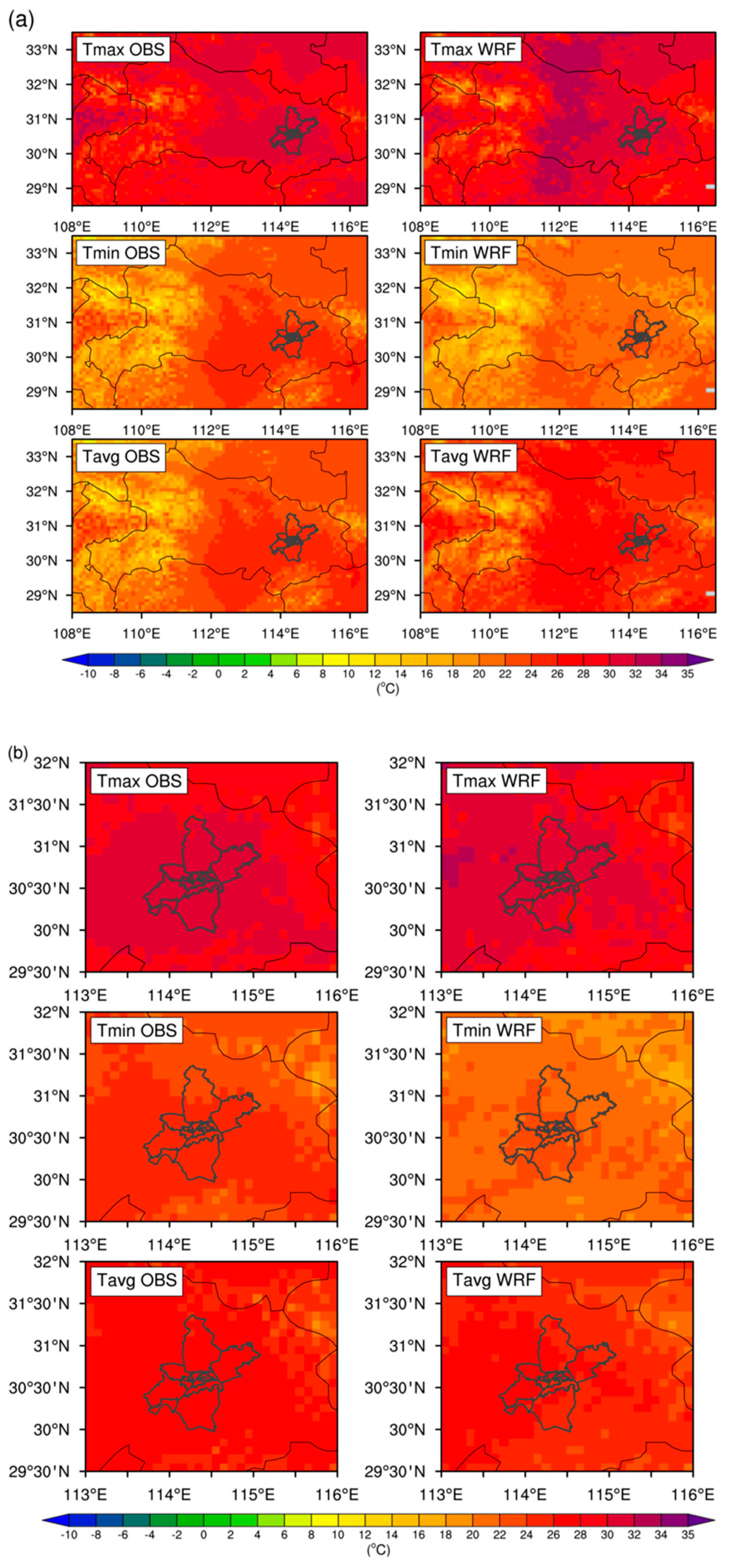


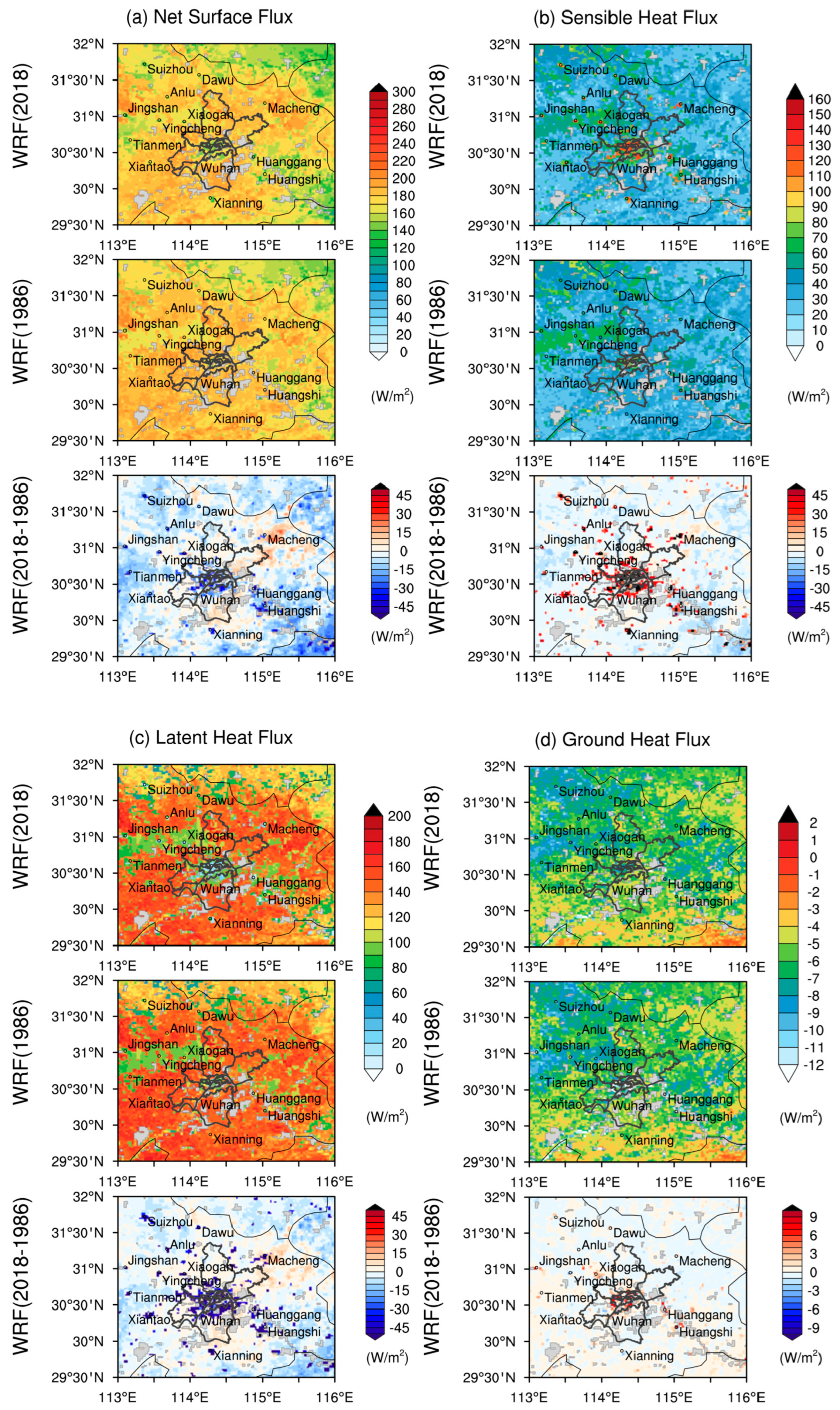

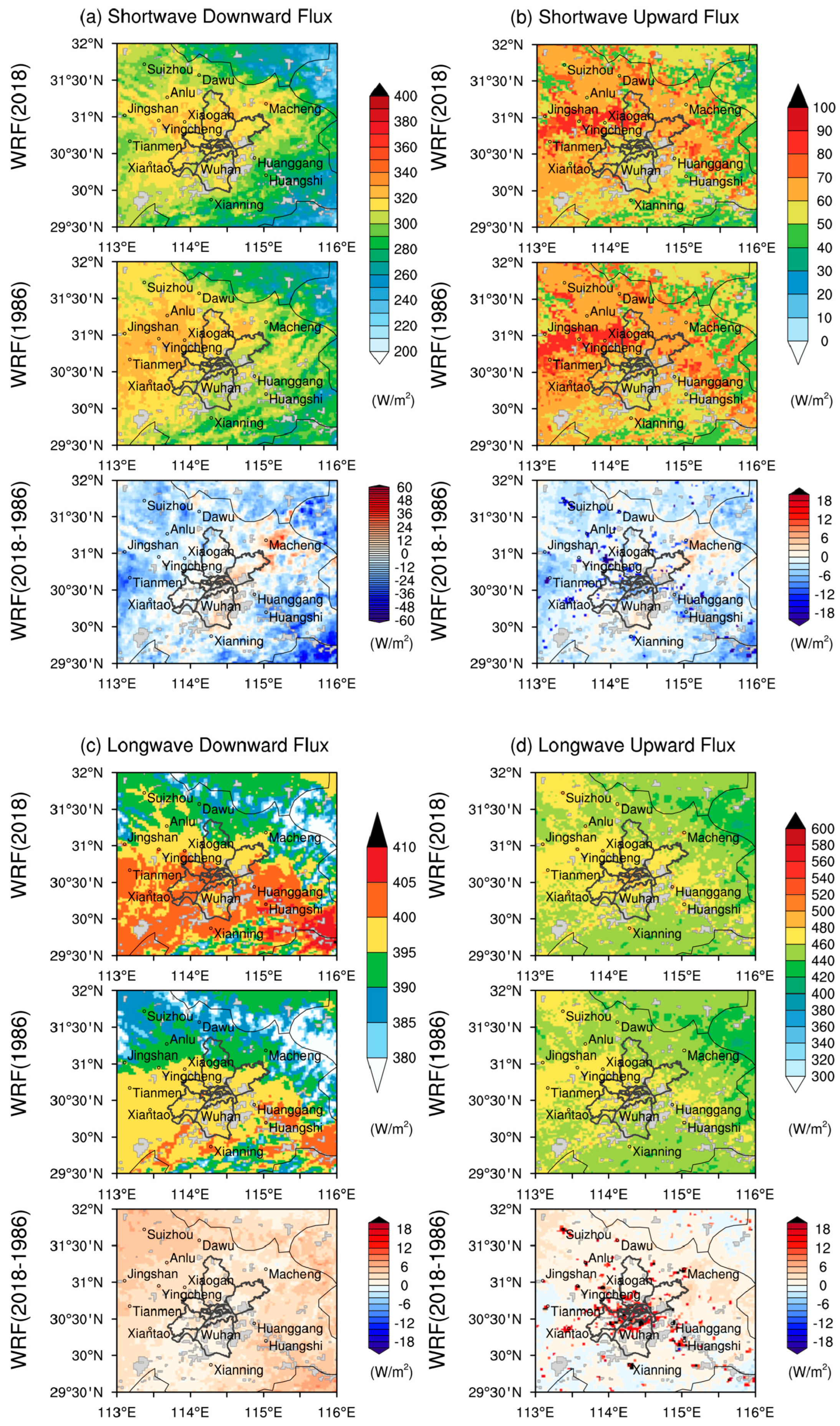

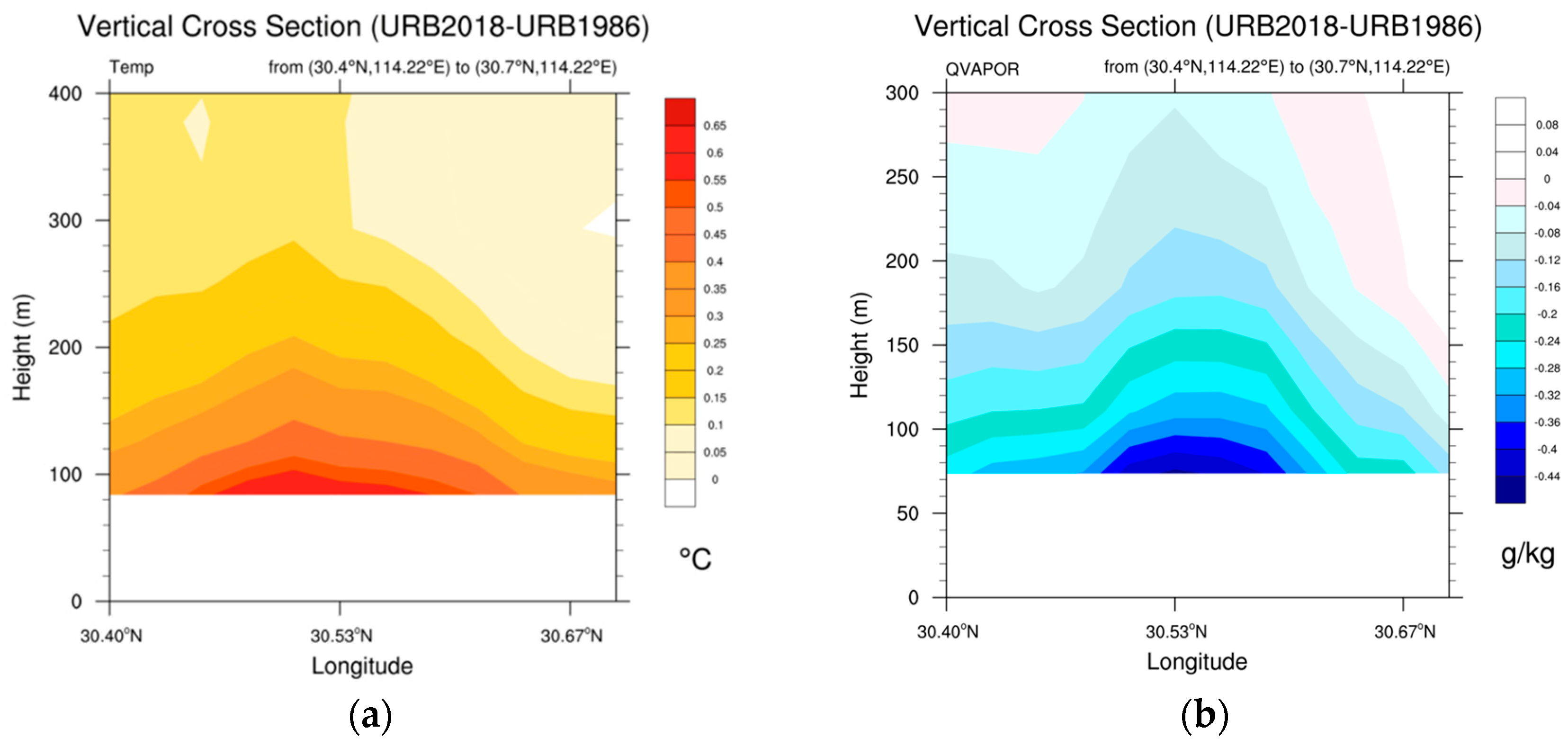
| Domain Setting/Boundary Condition/Physical Scheme | Options |
|---|---|
| Geographical Input | 1 km USGS land cover |
| dx, dy | 27 km, 9 km, 3 km |
| West–east (km) | 7452, 2403, 855 |
| South–north (km) | 4698, 1431, 594 |
| Vertical layers | 33 |
| Boundary conditions | ERA-Interim |
| Microphysics | WSM6 |
| Longwave | RRTMG |
| Shortwave | RRTMG |
| Land surface model | Unified Noah LSM |
| Cumulus scheme | KF scheme 1 |
| Boundary layer | YSU scheme |
| Urban Parameter | LIR | HIR | CIT |
|---|---|---|---|
| Building height | 5.0 | 7.5 | 10.0 |
| Road width | 8.3 | 9.4 | 10.0 |
| Fraction of the urban landscape occupied by artificial materials | 0.5 | 0.9 | 0.95 |
| Surface emissivity of roof/building wall/road | 0.9 | 0.9 | 0.9 |
| Surface albedo of roof/building wall/road | 0.2 | 0.2 | 0.2 |
| Anthropogenic heat | 20 | 50 | 90 |
| Hourly diurnal profile for anthropogenic heat (starting at 01:00 local time.) | 0.16 0.13 0.08 0.07 0.08 0.26 0.67 0.99 0.89 0.79 0.74 0.73 0.75 0.76 0.82 0.90 1.00 0.95 0.68 0.61 0.53 0.35 0.21 0.18 | ||
| Urban Categories | Label | Impervious Percentage |
|---|---|---|
| Low intensity residential | 31 | 30–70% |
| High intensity residential | 32 | 70–90% |
| Commercial/industrial/transportation | 33 | 90–100% |
| Experiment Name | Spin-up Period | Analysis Period | Summary |
|---|---|---|---|
| URBAN_1986 | 1 June 2015–30 June 2015 | 1 July–12 July 2015 | Urban state in 1986 |
| URBAN_2018 | 1 June 2015–30 June 2015 | 1 July–12 July 2015 | Urban state in 2018 |
Disclaimer/Publisher’s Note: The statements, opinions and data contained in all publications are solely those of the individual author(s) and contributor(s) and not of MDPI and/or the editor(s). MDPI and/or the editor(s) disclaim responsibility for any injury to people or property resulting from any ideas, methods, instructions or products referred to in the content. |
© 2024 by the author. Licensee MDPI, Basel, Switzerland. This article is an open access article distributed under the terms and conditions of the Creative Commons Attribution (CC BY) license (https://creativecommons.org/licenses/by/4.0/).
Share and Cite
Liu, S. Assessment of Regional Climate Effects of Urbanization around Subtropical City Wuhan in Summer Using Numerical Modeling. Atmosphere 2024, 15, 185. https://doi.org/10.3390/atmos15020185
Liu S. Assessment of Regional Climate Effects of Urbanization around Subtropical City Wuhan in Summer Using Numerical Modeling. Atmosphere. 2024; 15(2):185. https://doi.org/10.3390/atmos15020185
Chicago/Turabian StyleLiu, Siliang. 2024. "Assessment of Regional Climate Effects of Urbanization around Subtropical City Wuhan in Summer Using Numerical Modeling" Atmosphere 15, no. 2: 185. https://doi.org/10.3390/atmos15020185






